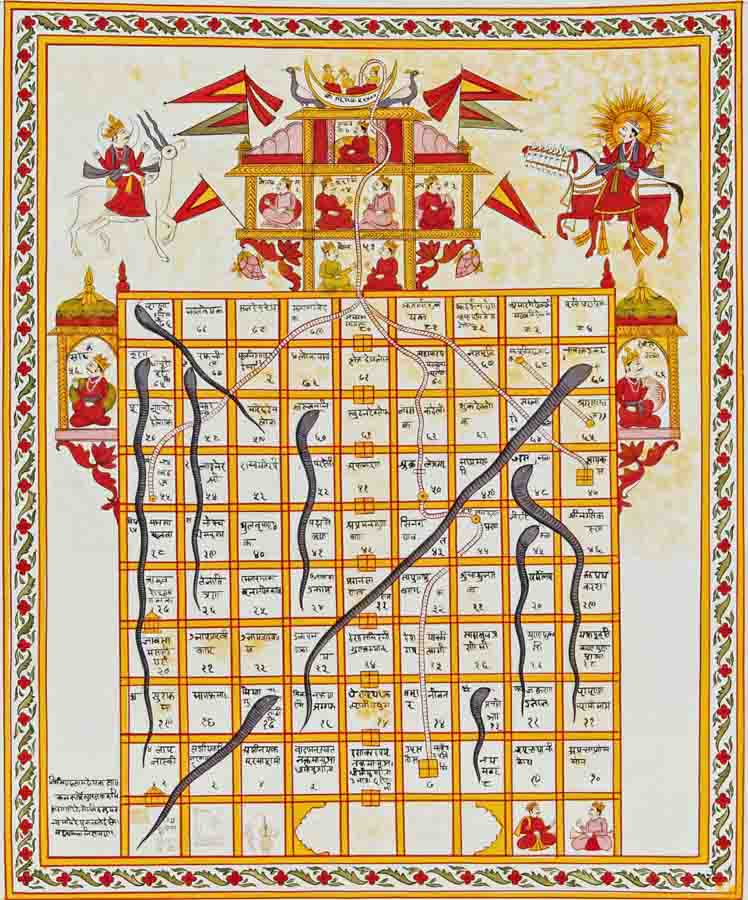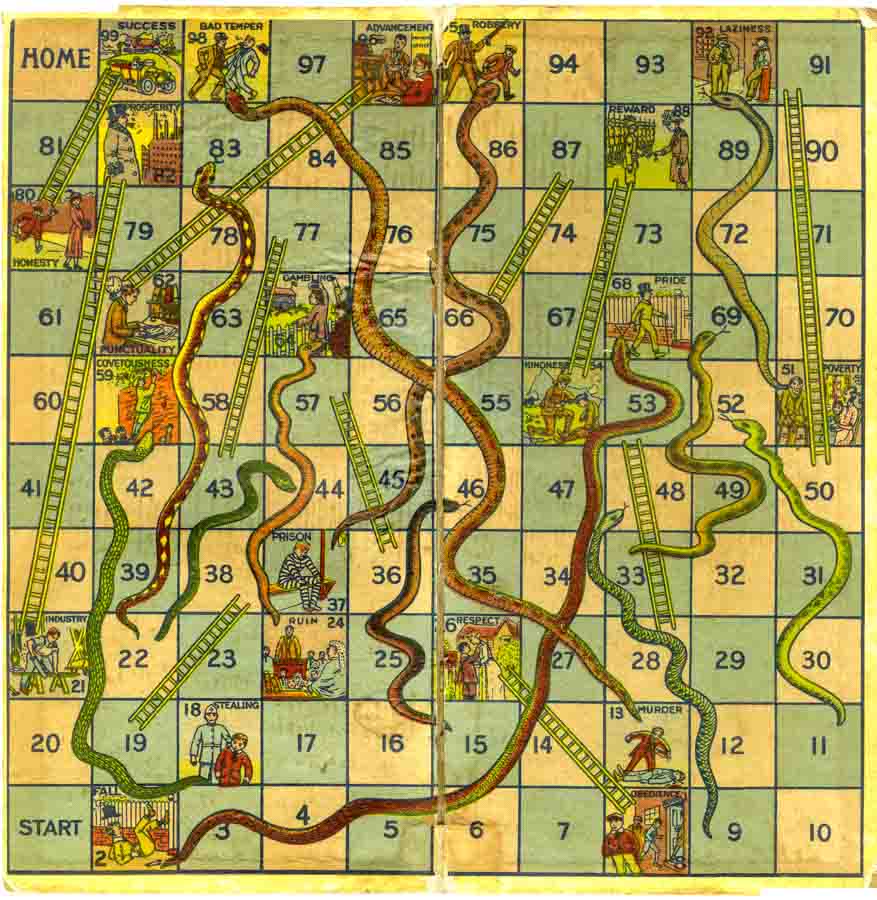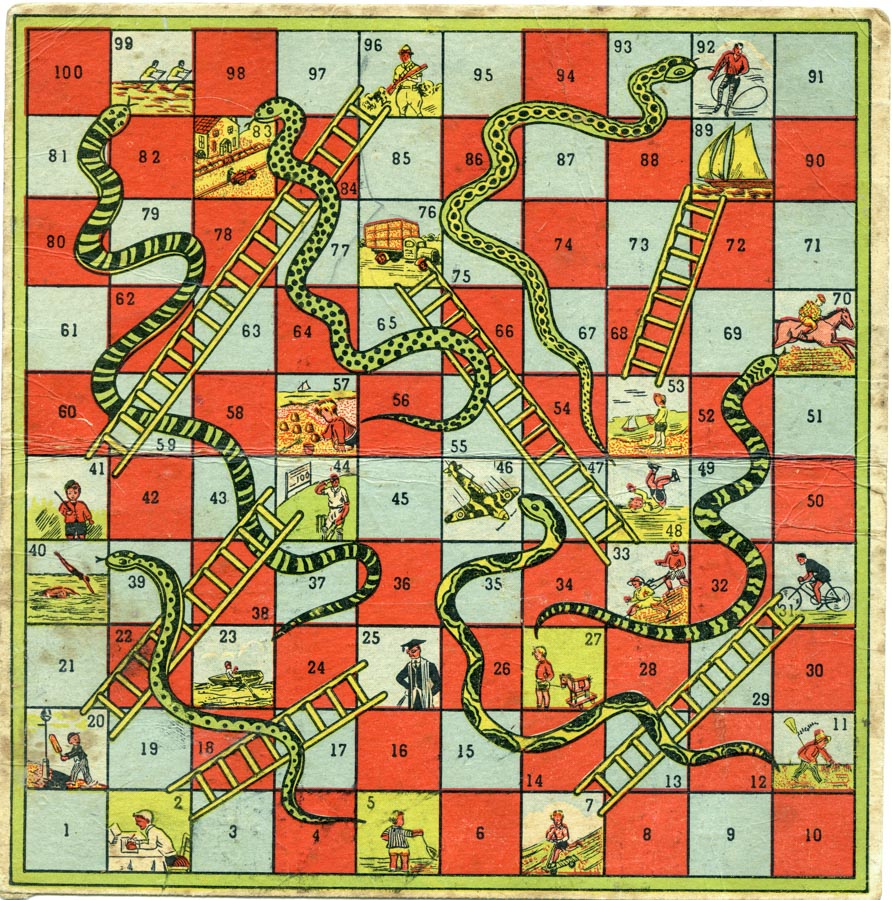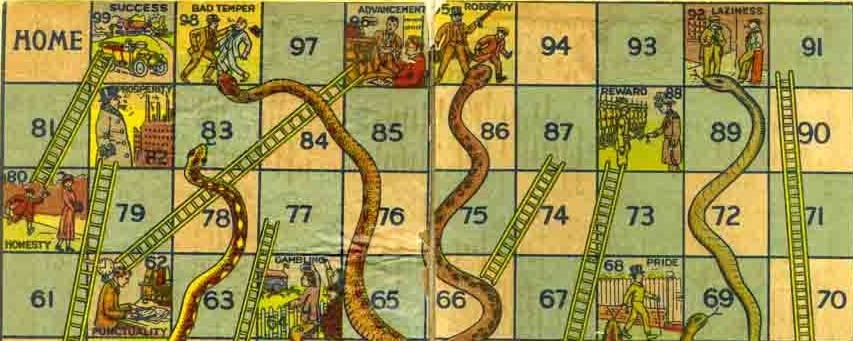Snakes will take you down, but ladders can lead you back up.
The snakes are bad deeds and attitudes. The ladders are virtues and good behaviour. But, problematically, whether you encounter a snake or a ladder depends on the random roll of a die.
I’m talking about Snakes and Ladders, of course, that old game some of us played when we were children. It’s a grid, like a bigger version of a chess board, and you roll a die to determine how many spaces you move your counter from square one to the top of the board. If you land on a square on which the foot of a ladder rests, you get to climb the ladder and leapfrog ahead. But if you land on a square that contains the head of a snake then it’s down you go.
When I played Snakes and Ladders as a child, it was the random element that eventually troubled me. I figured that deeds and attitudes were things you chose, rather than things that were foisted randomly upon you. These days, having seen somewhat more of life, I have modified my view a little, and will concede that luck can put people in situations where good intentions can go by the way, or give them the time and space and comfort they need to reflect on themselves and improve.
Which might be what the original makers of the game had in mind. Snakes and Ladders, I have learned, began in India as a game with a strong religious and moral meaning that was probably intended to be seen as spanning multiple lifetimes. Bad deeds in this lifetime might set one back in the next, and delay one’s hoped-for arrival at the goal of enlightenment. Good deeds, on the other hand, would bring advancement in lives to come.


In India, a version of the original game was called “Gyan Chauper” or “Moksha Patam” and, according to a very interesting Wikipedia article on the subject, these Indian versions had more snakes than ladders – a recognition in different terms that the road to hell is broad and easy to find, while the pathway to heaven is narrow and obscure.
Naturally when British colonists went back home from occupied India they took some of the games they had found and some of these were modified to suit the British sensibilities of those times. In Snakes and Ladders, then, the virtues and vices were those suited to Victorian interpretations of Christianity and the numbers of snakes and ladders were in some cases evened up, perhaps to emphasize opportunities for redemption.
For some years I’ve made a habit of collecting old versions of Snakes and Ladders, just to examine the different vices and virtues that makers of the different versions of the game have elected to portray.

The example above seems most typical of the Victorian version. It has notably far fewer ladders than snakes. The virtues are kindness, obedience, forgiveness, pity, truthfulness, faith and self-denial. The vices are covetousness, unpunctuality, frivolity, depravity, anger, robbery, selfishness, cruelty, quarrelsomeness, slander, vanity, avarice and pride. The relative importance of each vice or virtue is signified by the length of the snake or ladder and, perhaps, by its position on the grid of squares. Unpunctuality, it might be observed, will make one slip back 14 squares, while robbery will set you back 67, slander 68 and pride will cost you 62. It is interesting that the virtues are far more modest short-cuts upward than the vices downward. Faith is the best-yielding virtue, giving a 34-square boost but self-denial – though it only boosts you 20 squares – takes you straight to the winning post.

This version is somewhat different in that the numbers of ladders and snakes are more evenly matched. In many instances of both snakes and ladders on this board, the tops and bottoms are matched with labels that spell out the consequences of either good or bad actions. Gambling, for example, will lead to ruin and bad temper, we are warned, may lead to murder. Laziness is a fast-track to poverty, robbery leads to prison and covetousness may result in stealing. Pride, once again, is a big mistake since it leads, famously, to falls. Industry, on the other hand, leads to prosperity, honesty to success and punctuality to advancement. Interestingly, some snakes and ladders are unlabelled: perhaps players could imagine whatever unspecified vices and virtues they chose to consider, if they landed on those squares. Kindness, you might note, is given a military flavour on this board, with a generous soldier helping a wounded comrade and receiving the reward of a medal. It must be said that the pictures add a good deal to the game.

This example is an odd one, in that steers well clear of value judgements, dropping the moral and ethical aspect of the game altogether and simply depicting a linear causal connection between childhood activities and the adult versions of the same. A link is drawn between a student and a teacher, a child with a hobby horse and a jockey, a backyard cricketer and the scorer of a test century. There is nothing of vice or virtue: one imagines the snakes as a sort of chronological regression that comes about for no particular reason at all.
There are many other examples to be found, with subtle and not-so-subtle differences. When the game was introduced to America, I gather, it was apparently thought that children might find the depiction of snakes too alarming, so in that strange continent the reptiles have been replaced by inanimate chutes, which I suppose removes one element of menace from the downward slumps that rolling the die inevitably brings.
Is Snakes and Ladders a metaphor for life? Some people think so.
Are the ups and downs random? Are they consequences of conscious decisions? Or is it a bit of both?
Play the game, live the life and find out for yourself.




A very nice article about the history of a fine board game. Being a Game Developer I was creating a version of Snakes and Ladders, but I came to realize that it is more than a game. The old sub-continental version is different to modern version of this board game. Perhaps a life lesson taught in a fine manner.
Thanks for your comment. I’d like to see the game you make..